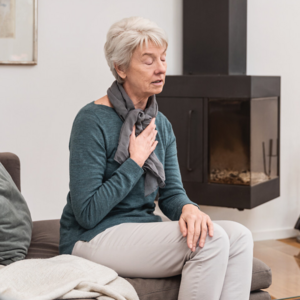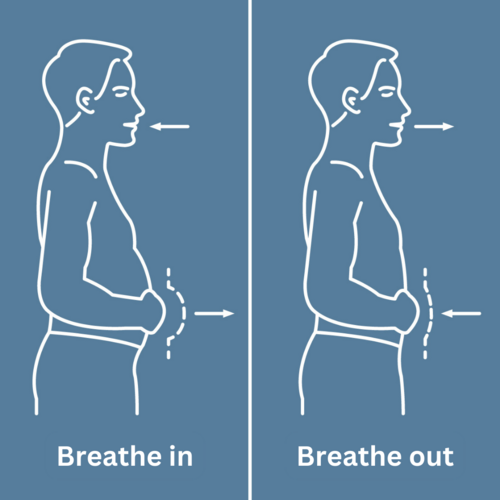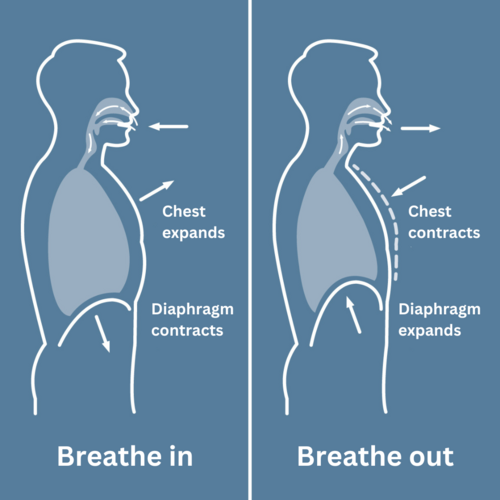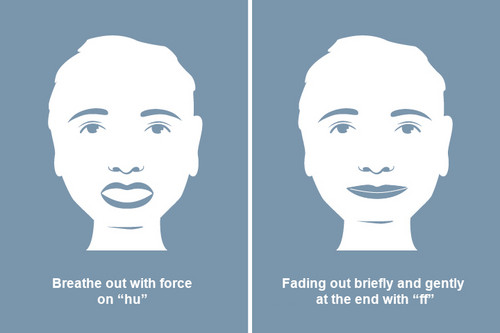
Mucus forming in the lungs during an infection is a normal physiological reaction. Goblet cells within the airways produce more mucus so pathogens can be trapped and quickly transported out of the system. At the same time, the mucous membranes become swollen because many immune defence cells are being transported to the site of the infection.
More mucus and swollen mucous membranes constrict the airways, which is also where air flows. So, breathing can become more difficult. By doing certain exercises, mucus in the lungs can be mobilised from within the lungs into the larger airways so that it can be cleared more easily.
We asked Gemma Stanford this question. She is a physiotherapist who works with patients who have chronic respiratory problems, helping them with exercises to clear mucus from their lungs and airways. Not only are these exercises suitable for patients with chronic lung diseases such as COPD, cystic fibrosis, PCD and chronic bronchitis, they are also appropriate for times when the lungs and bronchi are acutely congested with mucus due to colds, bronchitis or pneumonia.
Breathing exercises to mobilise mucus will be most effective if you are well hydrated as this helps the mucus to be more mobile, ensure you have drunk enough fluids before you start. If your mucus seems very sticky to clear you may benefit from using a nebuliser device such as the PARI BOY Classic to inhale a saline solution which can help to loosen the mucus before your breathing exercises. Talk to your healthcare professionals if you want to try a nebuliser to help loosen your mucus.
Make sure you clear your nose and upper airways before starting your breathing exercises, a gentle blow of your nose will help optimise your clearance.
Exercise can help to loosen sputum, some people find that a walk or run before completing breathing exercises allows them to clear their lungs quicker than breathing exercises alone. Any type of exercise where you are breathing deeper can help to mobilise sputum.
Special breathing exercises have been developed to help mobilise mucus, these include the Active Cycle of Breathing Techniques and Autogenic Drainage. Both of these techniques can be completed independently and can be used alongside equipment such as the PARI PEP systems. Your respiratory physiotherapist can work with you to find the best exercises for you to use and will be able to make sure your technique is optimal.
The Active Cycle of Breathing Techniques are a set of three exercises which are combined to help mobilise mucus. You can repeat each part of the cycle as much as necessary to clear your lungs, ensuring you use the relaxed breathing to rest in-between the more active parts.
The first part of ACBT is relaxed breathing. Sit or lie in a comfortable position, making sure that you have relaxed your shoulders and upper chest. You are aiming to breathe using your diaphragm (the dome shaped muscle that sits under your lungs), so that when you breathe in your lower chest expands and your upper chest and shoulders stay fairly still.
Relaxed breathing is the resting part of ACBT and should be used in-between the more active parts and also whenever you feel like you need a rest.


TEEs are deep breaths, ideally taken in through your nose and aiming to fill your lungs from the bottom upwards. Try to focus on expanding your lower chest first rather than raising your shoulders as you breathe in. Once you feel you cannot take any more air in, pause and keep trying to breathe in for 3 seconds before slowly breathing out. Repeat this exercise three to four times before going back to relaxed breathing. You can use a PARI PEP device with the TEEs to assist in loosen your mucus.
TEEs are the part of ACBT which help to loosen the mucus from within your lungs by allowing air to get behind secretions in the smaller airways, as you breathe out the air can “push” the mucus up the airways towards the mouth.
If once you have completed a set of TEEs followed by relaxed breathing you do not feel your mucus is loose as yet, you can repeat the TEEs before moving on to step 3.
The FET or huffing is a great way to move mucus from your airways to enable a focused cough and clearance when you feel that your mucus has been loosened enough.
The FET is a combination of one or two forced expirations with relaxed breathing. The forced expirations are completed with a wide, open mouth aiming to keep the back of your throat open, breathing out like you are steaming up a mirror. Mucus will move from different parts of your lungs depending upon the size of your breath in and the length of your huff out – your physiotherapist can guide you on this. Be careful not to huff too hard, as this can cause airway narrowing which will not help your sputum to move.
Huffing, when done well, is a very effective way to move mucus up the airways so you can cough it out. Your huff should be taught by a physiotherapist and should be checked regularly to ensure it is optimal. You should only cough if needed once you have completed your huffs.

Input for this article was given by Dr Gemma Stanford, Clinical Specialist Physiotherapist at the Royal Brompton Hospital, London, UK.
Note: The information in this blog post is not a treatment recommendation. The needs of patients vary greatly from person to person. The treatment approaches presented should be viewed only as examples. PARI recommends that patients always consult with their physician or physiotherapist first.
An article written by the PARI BLOG editorial team.
© 2025 PARI GmbH Spezialisten für effektive Inhalation